The color-printing industry—influenced by consumer preferences and ongoing technological advancements—continues to blossom in a digital world. A far cry from bare-bones analog technology common in years past, modern methods present endless possibilities.
A Palette of Possibilities
5 Color-Printing Methods Powering the Personalization Industry
By Stefanie Galeano-Zalutko
(Originally printed in the January/February 2025 issue of Insights.)
The color-printing industry—influenced by consumer preferences and ongoing technological advancements—continues to blossom in a digital world. A far cry from bare-bones analog technology common in years past, modern methods present endless possibilities.
“The evolution of full-color printing methods in custom-apparel decoration [in particular] has revolutionized the industry, creating more vibrant, durable, and versatile prints than ever before,” says Karin Bellinghausen, vice president of content and communications at Stahls’.
Within the personalization industry, significant progress in color-printing quality, efficiency, and cost also paves the way for more small- and medium-
sized businesses to find success in the market, explore niche segments, and make their individual mark in customization.
But which color-printing method is right for your business? Below, we analyze some of the best methods powering the personalization industry.
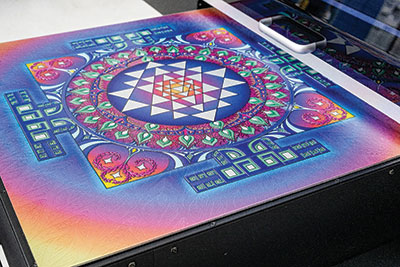
Image courtesy of LogoJET
UV Printing
UV printing is a digital, direct-to-substrate method that harnesses UV light to cure inks instantly—making it a highly effective option for a wide range of materials, from glass and acrylic to wood and metal. Known for its versatility, durability, and efficiency, UV printing is an increasingly popular method within the personalization industry.
“Its full-color capability allows retailers to meet the precise color requirements of corporate branding, which is especially appealing in the promotional products market where accurate brand colors are essential,” says Susan Cox, founder and CEO of LogoJET.
In addition to vibrant color output and easy personalization, UV printing features a long-lasting application, resists fade and wear, and boasts quick turnaround times.
Environmentally friendly inks and substrates are trending, along with sophisticated software options that enable variable-data printing to ensure easy customization. Techniques like UV clear varnish and textured printing are on the rise as well—allowing for intricate embellishments and expanded applications, from ADA-compliant braille signage to artistic finishes that add depth and sophistication.
The integration of color printing and laser technology can also expand product-manufacturing options and empower shops to offer intricate designs and hybrid solutions that combine engraving with vibrant color printing.
“These advancements enable shops to diversify their offerings and cater to specialized markets with unique, high-value products,” Cox says.
While UV printing requires a substantial up-front investment in equipment, Cox says it often yields impressive ROI since it serves multiple industries and product types. As with any equipment, UV printers require regular upkeep, including ink management and nozzle checks, to ensure quality and longevity.
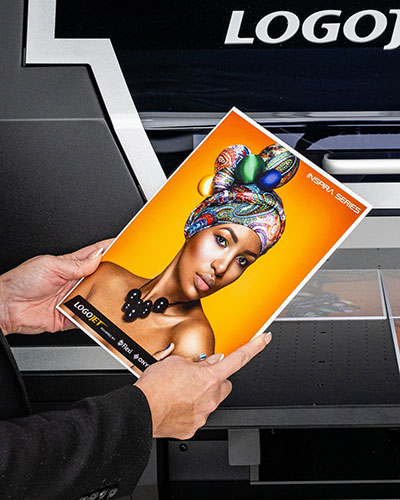
Image courtesy of LogoJET
There is a learning curve with methods like UV printing and sublimation—both of which require knowledge of color calibration and substrate preparation, thus posing challenges for businesses without a strong technical foundation. However, Cox says the juice is worth the squeeze.
“For those considering UV printing, it’s essential to assess customer needs, evaluate equipment longevity, and understand the maintenance requirements,” she says. “Investing in training and quality equipment can enhance service offerings and open new revenue streams in custom printing.”
Sublimation
Sublimation—a full-color, high-definition printing process—is known for its vibrancy, detail, and finish.
“In today’s market, sublimation continues to be one of the top choices due to its versatility, quality, and ease of application, allowing companies to deliver high-value personalized products that stand out,” says Tobe Hall, sales director at Technotape International LLC.
Initially, sublimation was more of a niche method, limited to simple, flat surfaces like plaques or photo panels. But thanks to technological developments, the method has expanded to include a variety of compatible products, which span fashion and sportswear, as well as mugs, phone cases, and even metal decor.
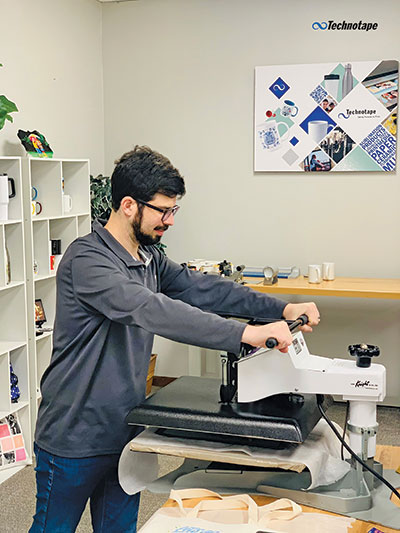
Image courtesy of Technotape International LLC
“Dye sublimation is the print method of choice for vibrancy, surface quality, and longevity,” Hall says. “The key to a quality sublimation print is the material. Sublimation dyes bond effectively with polyester, so items coated or blended with this material yield the best results.”
Unlike other color-printing methods, sublimation transforms dye into gas without going through a liquid stage. During the process, ink becomes a permanent part of the material itself to ensure detailed graphics are deeply embedded. As such, sublimation preserves a fabric’s original stretch and flexibility and resists peeling, cracking, and fading compared to other decoration processes, explains Austin Weisenbach, sublimation specialist at JDS Industries.
Sublimation ink is also directly injected throughout the entire thickness of a hard good’s coating—creating durability and resistance to surface scratches and moisture.
“The biggest strengths of sublimation are permanence and price,” Weisenbach says. “One shirt can be printed and pressed in just a couple of minutes.”

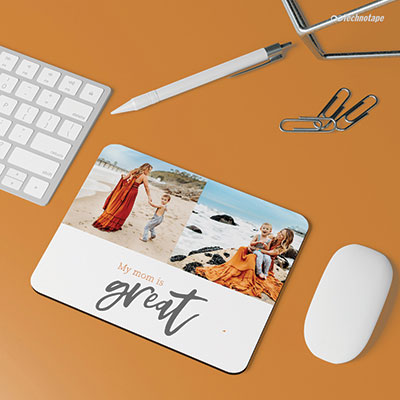
Images courtesy of Technotape International LLC
In addition to producing higher-resolution imagery, modern sublimation inks, printers, and transfer papers have a lower environmental impact due to reduced waste.
Kick-starting sublimation at a shop is one of the least expensive color-printing options. All one needs is a printer and a heat press, and the only consumable costs are sublimation ink and paper. Maintenance is also more efficient compared to other color-printing equipment.
Looking ahead, Weisenback and Hall expect the sublimation market to continue to reach new heights alongside ongoing innovation.
“It is likely to remain a key player in the world of customized products for years to come,” Hall says. “While UV printing has a broader application range and a larger market size, sublimation printing maintains strong demand in specific niches, especially where high-quality textile printing and personalization are prioritized.”
Heat-Transfer Vinyl
Heat-transfer vinyl is a thin, flexible material that can be cut or printed to decorate a wide range of garment materials, from cotton and polyester to nylon and blends. While it is primarily designed for fabrics, it can also be used on materials such as acrylic, metal, glass, wood, and ceramic, with appropriate preparation and application techniques.
“Heat-transfer vinyl will meld into the contours of a fabric, revealing the texture of the fibers beneath, but it will remain a separate layer, as it does not bond at the molecular level,” says Dave Haan, business development manager at JDS Industries.
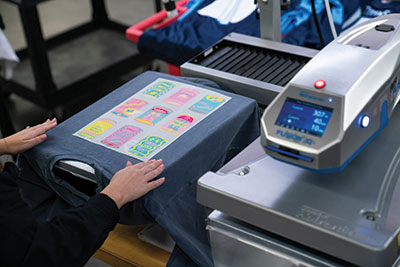
Image courtesy of Stahls'
Originally, heat-transfer vinyl was limited to single-color designs, requiring manual layering for multicolor graphics—a time-consuming and labor-intensive process. However, the dawn of printable heat-transfer vinyl allowed for the printing of full-color designs directly onto vinyl using inkjet or solvent printers, streamlining the production process and enabling more complex graphics.
“In the early 2000s, garment decorators gained the ability to print complex, full-color images onto vinyl that can be cut and heat applied to apparel,” Bellinghausen says. “This method allows for incredibly detailed designs with precise colors, and the printed media can be heat applied on various fabric types.”
Since heat-transfer vinyl is versatile in design and application across various fabrics and substrates, it is also a suitable option for flat or slightly curved non-apparel items such as home decor, coasters, portfolios, bags, key rings, and more. Modern materials are rapidly evolving as well, including substrates with more eye-catching colors and textures, like glitter, twill, and dimensional soft foam.

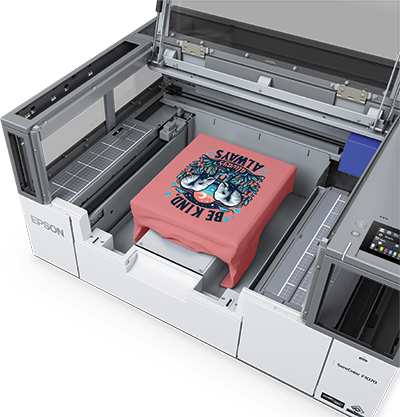
Images courtesy of JDS Industries
“There’s a growing demand for custom emblems and patches, particularly for hats. These products have a premium look and feel that customers love, and they allow you to set your business apart with unique, high-quality designs,” says Josh Ellsworth, chief revenue officer at Stahls’.
Despite some limitations, including scalability for high-volume orders and stiff competition from alternative printing methods with arguably faster production, Haan says heat-transfer vinyl is “an appealing and profitable business channel” with a lot of energy moving forward.
“The heat-transfer-vinyl market is a low-threshold, high-potential proposition. The cost of entering the market is relatively low. The learning curve is fairly flat, and whoever your customers are now, the odds are very good they will be interested in products personalized with heat-transfer vinyl,” Haan says.
As color-printing methods continue to evolve, heat-transfer vinyl will integrate with emerging technologies tofurther improve overall quality and efficiency.
“By mastering this technique, you’re not just adding another product to your shop—you’re creating opportunities to attract new markets and grow your business in a very competitive industry,” Ellsworth says.
Direct to Garment
The direct-to-garment method (DTG) emerged as a game changer for the custom-apparel industry. This process requires an item to be pretreated with a bonding agent, after which ink is applied directly to the garment and absorbed into the fibers. DTG uses a water-based pigment ink that is specially designed for fabric printing.
“It’s different from other color-printing technologies that involve printing to a transfer then pressing that transfer onto a final substrate,” says Jackie Faeth, marketing coordinator at The Rowmark Group.
Once printed, a DTG item is carefully removed from the printer and placed onto a conveyor dryer to evaporate the pretreatment and cure the ink, resulting in a durable, lasting print that feels smooth to the touch.
At one time, DTG was limited by slower production speeds and lower durability. However, recent advancements in ink formulations, pretreatment methods, and printer technology have addressed these areas of concern.
While limitations still exist regarding DTG’s ability to customize uncommon locations or specialty items, customers turn to the method for complex designs, hyperrealistic imagery, and fine details that involve various colors and gradients.
Likewise, shops are drawn to achieving a full-color print quickly, without the hassle of setting up multiple screens. DTG also allows decorators to print on dark-cotton T-shirts “without the tedious, multistep process of toner heat transfer,” Faeth says.
Compared to traditional screen printing, DTG reduces the risk of overproduction and minimizes textile waste, as products are printed on demand with no order minimums. To maximize efficiency, Faeth says shop personnel can store pretreated shirts for future use.
“DTG is the way to go. You get the benefit of full-color printing with the ability to quickly customize and edit, minus the mess of setting up multiple screens,” Faeth says. “Plus, the hand, or feel, of the print is great and stretches, making it an easy sell.”
DTG equipment is more accessible and affordable than it was previously, making it approachable for home-based users and small businesses. And DTG technology is growing alongside direct-to-film (DTF)—complementing the former’s inability to process polyester materials. Some machines allow users to switch back and forth between the methods.

Image courtesy of JDS Industries
Direct to Film
Direct-to-film (DTF) printing is the latest addition within color printing, quickly gaining in popularity and integrating well with other technologies. DTF transfers involve printing a design onto a special film, coating it with adhesive powder, and curing it before heat pressing onto the fabric.
DTF prints are known for their color accuracy, brightness, and crisp, defined edges—giving shops a blank canvas to reproduce complex and vivid designs on various apparel.
“It’s a promising versatile technology that can solve a lot of logo needs,” says Brett Stahl, chief innovation officer at Stahls’.
Users can print a plethora of color options, explore beautiful gradients and shading, as well as complete fine details like floating text without obnoxious outlines. Since DTF is heat pressed at lower temperatures, professionals also eliminate the dreaded scorch mark during application. In addition, the adhesive layer creates a strong bond between the ink and fabric, resulting in prints that withstand extensive washing and stretching without peeling, cracking, or fading.
“This high-quality, durable output is a huge advantage for both shop owners and customers who expect longevity in their apparel,” Stahl says, noting DTF’s value proposition compared to other methods.
DTF transfers can be applied to any type of garment in nearly any desired location. The method adheres well to both light and dark colors across various fabric types, unlike sublimation, which works best on polyester and light-colored fabrics. Similarly, while DTG printing can be limited to cotton or natural fibers and requires pretreatment on dark fabrics, DTF can be applied directly to synthetics and blends without pretreatment.
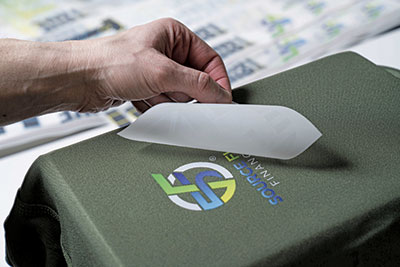
Image courtesy of Stahls'
“As demand shifts toward faster, lower-quantity production, decorators are finding that embracing this approach can be a game changer,” says Ellsworth.
Shop personnel looking to explore DTF are encouraged to do their research. DTF printers are expensive, and the setup can get quite involved. A less expensive option is to partner with a DTF-transfer company, in which case all a shop owner would need on hand is a quality heat press to apply designs.
“Not all DTF-transfer companies are created equal,” Stahl reminds. “There is quite a bit of variability in the market with feel, finish, and durability, so it is recommended that apparel decorators consider sampling from transfer suppliers to find the right fit.”
In addition to partnering with a trusted supplier, it is impor-tant for shop owners to consider which color-printing method is best for the individual project at hand.
“DTF has become synonymous with the word ‘transfers,’ but it’s important for people, especially those who are new in the business, to understand there are many types of transfers. DTF is not a one-size-fits-all,” says Carleen Gray, CEO at Stahls’. “I would caution new users to do their research and choose the best decoration technology for the job.”
Stefanie Galeano-Zalutko leads Zalutko Business Services, Inc., a marketing agency based in central Florida. She can be reached at szalutko@zalutkobusiness.com
